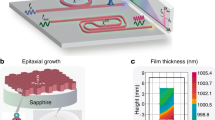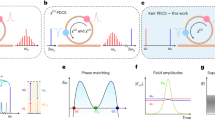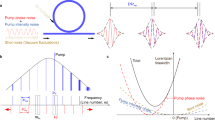Abstract
Kerr soliton microcombs have recently emerged as a prominent topic in integrated photonics and have enabled new horizons for optical frequency metrology. Kerr soliton microcombs, as the name suggests, are based on high-order cubic optical nonlinearity. It is desirable to exploit quadratic photonic materials, namely Pockels materials, for soliton generation and on-chip implementation of 1f–2f comb self-referencing. Such quadratically driven solitons have been proposed theoretically, but have not yet been observed in a nanophotonic platform, despite recent progress in quadratic comb generation in free-space and crystalline resonators. Here, we report photonic-chip-based Pockels microcomb solitons driven by three-wave mixing in an aluminium nitride microring resonator. In contrast to typical Kerr solitons, the Pockels soliton features unity soliton generation fidelity, two-by-two evolution of multi-soliton states, favourable tuning dynamics and high pump-to-soliton conversion efficiency.
This is a preview of subscription content, access via your institution
Access options
Access Nature and 54 other Nature Portfolio journals
Get Nature+, our best-value online-access subscription
$29.99 / 30 days
cancel any time
Subscribe to this journal
Receive 12 print issues and online access
$209.00 per year
only $17.42 per issue
Buy this article
- Purchase on Springer Link
- Instant access to full article PDF
Prices may be subject to local taxes which are calculated during checkout




Similar content being viewed by others
Data availability
The data that support the plots within this paper and other findings of this study are available from the corresponding author upon reasonable request.
References
Kippenberg, T. J., Holzwarth, R. & Diddams, S. A. Microresonator-based optical frequency combs. Science 332, 555–559 (2011).
Gaeta, A. L., Lipson, M. & Kippenberg, T. J. Photonic-chip-based frequency combs. Nat. Photon. 13, 158–169 (2019).
Spencer, D. T. et al. An optical-frequency synthesizer using integrated photonics. Nature 557, 81–85 (2018).
Papp, S. B. et al. Microresonator frequency comb optical clock. Optica 1, 10–14 (2014).
Newman, Z. L. et al. Architecture for the photonic integration of an optical atomic clock. Optica 6, 680–685 (2019).
Suh, M.-G. et al. Searching for exoplanets using a microresonator astrocomb. Nat. Photon. 13, 25–30 (2019).
Obrzud, E. et al. A microphotonic astrocomb. Nat. Photon. 13, 31–35 (2019).
Picqué, N. & Hänsch, T. W. Frequency comb spectroscopy. Nat. Photon. 13, 146–157 (2019).
Dutt, A. et al. On-chip dual-comb source for spectroscopy. Sci. Adv. 4, e1701858 (2018).
Kues, M. et al. Quantum optical microcombs. Nat. Photon. 13, 170–179 (2019).
Herr, T. et al. Universal formation dynamics and noise of Kerr-frequency combs in microresonators. Nat. Photon. 6, 480–487 (2012).
Kippenberg, T. J., Gaeta, A. L., Lipson, M. & Gorodetsky, M. L. Dissipative Kerr solitons in optical microresonators. Science 361, eaan8083 (2018).
Stern, B., Ji, X., Okawachi, Y., Gaeta, A. L. & Lipson, M. Battery-operated integrated frequency comb generator. Nature 562, 401–405 (2018).
Guo, X. et al. Efficient generation of a near-visible frequency comb via Cherenkov-like radiation from a Kerr microcomb. Phys. Rev. Appl. 10, 014012 (2018).
He, Y. et al. Self-starting bi-chromatic LiNbO3 soliton microcomb. Optica 6, 1138–1144 (2019).
Liu, X. et al. Beyond 100-THz-spanning ultraviolet frequency combs in a non-centrosymmetric crystalline waveguide. Nat. Commun. 10, 2971 (2019).
Hickstein, D. D. et al. Ultrabroadband supercontinuum generation and frequency-comb stabilization using on-chip waveguides with both cubic and quadratic nonlinearities. Phys. Rev. Appl. 8, 014025 (2017).
Xue, X. et al. Second-harmonic-assisted four-wave mixing in chip-based microresonator frequency comb generation. Light Sci. Appl. 6, e16253 (2017).
Yang, Q.-F., Yi, X., Yang, K. Y. & Vahala, K. Stokes solitons in optical microcavities. Nat. Phys. 13, 53–57 (2017).
Skryabin, D. V. & Champneys, A. R. Walking cavity solitons. Phys. Rev. E 63, 066610 (2001).
Ulvila, V., Phillips, C. R., Halonen, L. & Vainio, M. Frequency comb generation by a continuous-wave-pumped optical parametric oscillator based on cascading quadratic nonlinearities. Opt. Lett. 38, 4281–4284 (2013).
Ricciardi, I. et al. Frequency comb generation in quadratic nonlinear media. Phys. Rev. A 91, 063839 (2015).
Mosca, S. et al. Direct generation of optical frequency combs in χ2 nonlinear cavities. Nanophotonics 5, 316–331 (2016).
Mosca, S. et al. Modulation instability induced frequency comb generation in a continuously pumped optical parametric oscillator. Phys. Rev. Lett. 121, 093903 (2018).
Jankowski, M. et al. Temporal simultons in optical parametric oscillators. Phys. Rev. Lett. 120, 053904 (2018).
Leo, F. et al. Frequency-comb formation in doubly resonant second-harmonic generation. Phys. Rev. A 93, 043831 (2016).
Hansson, T. et al. Quadratic soliton combs in doubly resonant second-harmonic generation. Opt. Lett. 43, 6033–6036 (2018).
Villois, A. & Skryabin, D. V. Soliton and quasi-soliton frequency combs due to second harmonic generation in microresonators. Opt. Express 27, 7098–7107 (2019).
Villois, A., Kondratiev, N., Breunig, I., Puzyrev, D. N. & Skryabin, D. V. Frequency combs in a microring optical parametric oscillator. Opt. Lett. 44, 4443–4446 (2019).
Ikuta, R., Asano, M., Tani, R., Yamamoto, T. & Imoto, N. Frequency comb generation in a quadratic nonlinear waveguide resonator. Opt. Express 26, 15551–15558 (2018).
Hendry, I. et al. Experimental observation of internally pumped parametric oscillation and quadratic comb generation in a χ2 whispering-gallery-mode microresonator. Opt. Lett. 45, 1204–1207 (2020).
Szabados, J. et al. Frequency comb generation via cascaded second-order nonlinearities in microresonators. Phys. Rev. Lett. 124, 203902 (2020).
Schliesser, A., Picqué, N. & Hänsch, T. W. Mid-infrared frequency combs. Nat. Photon. 6, 440–449 (2012).
Herr, S. J. et al. Frequency comb up- and down-conversion in synchronously driven χ2 optical microresonators. Opt. Lett. 43, 5745–5748 (2018).
Guo, X., Zou, C.-L., Jung, H. & Tang, H. X. On-chip strong coupling and efficient frequency conversion between telecom and visible optical modes. Phys. Rev. Lett. 117, 123902 (2016).
Bruch, A. W., Liu, X., Surya, J. B., Zou, C.-L. & Tang, H. X. On-chip χ2 microring optical parametric oscillator. Optica 6, 1361–1366 (2019).
Li, M., Zou, C.-L., Dong, C.-H., Ren, X.-F. & Dai, D.-X. Enhancement of second-harmonic generation based on the cascaded second-and third-order nonlinear processes in a multimode optical microcavity. Phys. Rev. A 98, 013854 (2018).
Breunig, I. Three-wave mixing in whispering gallery resonators. Laser Photon. Rev. 10, 569–587 (2016).
Liu, X. et al. Integrated high-Q crystalline AlN microresonators for broadband Kerr and Raman frequency combs. ACS Photonics 5, 1943–1950 (2018).
Herr, T. et al. Temporal solitons in optical microresonators. Nat. Photon. 8, 145–152 (2014).
Szabados, J., Sturman, B. & Breunig, I. Frequency comb generation threshold in χ(2) optical microresonators. Preprint at https://arxiv.org/abs/2007.05287 (2020).
Boyd, R. W. Nonlinear Optics (Elsevier, 2003).
Zhang, S. et al. Sub-milliwatt-level microresonator solitons with extended access range using an auxiliary laser. Optica 6, 206–212 (2019).
Bao, C. et al. Nonlinear conversion efficiency in Kerr frequency comb generation. Opt. Lett. 39, 6126–6129 (2014).
Gong, Z. et al. High-fidelity cavity soliton generation in crystalline AlN micro-ring resonators. Opt. Lett. 43, 4366–4369 (2018).
Brasch, V., Geiselmann, M., Pfeiffer, M. H. & Kippenberg, T. J. Bringing short-lived dissipative Kerr soliton states in microresonators into a steady state. Opt. Express 24, 29312–29320 (2016).
Brasch, V. et al. Photonic chip-based optical frequency comb using soliton Cherenkov radiation. Science 351, 357–360 (2016).
Pfeiffer, M. H. et al. Octave-spanning dissipative Kerr soliton frequency combs in Si3N4 microresonators. Optica 4, 684–691 (2017).
Li, Q. et al. Stably accessing octave-spanning microresonator frequency combs in the soliton regime. Optica 4, 193–203 (2017).
Lu, J. et al. Periodically poled thin-film lithium niobate microring resonators with a second-harmonic generation efficiency of 250,000%/W. Optica 6, 1455–1460 (2019).
Chen, J.-Y. et al. Ultra-efficient frequency conversion in quasi-phase-matched lithium niobate microrings. Optica 6, 1244–1245 (2019).
Acknowledgements
This work is supported by DARPA SCOUT (W31P4Q-15-1-0006). H.X.T. acknowledges support from DARPA’s ACES programmes as part of the Draper-NIST collaboration (HR0011-16-C-0118) and a NSF EFRI grant (EFMA-1640959), as well as from the David and Lucile Packard Foundation. We thank Y. Sun, S. Reinhart, K. Woods and M. Rooks for assistance with device fabrication.
Author information
Authors and Affiliations
Contributions
A.W.B. and H.X.T. conceived the experimental design. A.W.B. performed device fabrication, measurements and data analysis, with assistance from X.L., Z.G. and J.B.S. M.L. and C.-L.Z. performed numerical simulations and provided theoretical support. A.W.B. and H.X.T. wrote the manuscript, with input from all other authors. H.X.T. supervised the project.
Corresponding author
Ethics declarations
Competing interests
The authors declare no competing interests.
Additional information
Publisher’s note Springer Nature remains neutral with regard to jurisdictional claims in published maps and institutional affiliations.
Supplementary information
Supplementary Information
Supplementary Figs. 1–4 and Notes 1–3.
Supplementary Video 1
Evolution of the Pockels soliton from the numerical simulation.
Rights and permissions
About this article
Cite this article
Bruch, A.W., Liu, X., Gong, Z. et al. Pockels soliton microcomb. Nat. Photonics 15, 21–27 (2021). https://doi.org/10.1038/s41566-020-00704-8
Received:
Accepted:
Published:
Issue Date:
DOI: https://doi.org/10.1038/s41566-020-00704-8



